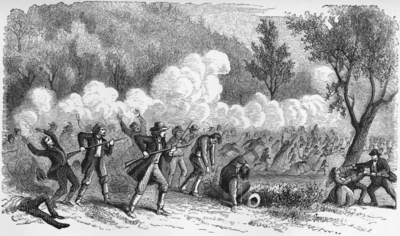General Discussion
Related: Editorials & Other Articles, Issue Forums, Alliance Forums, Region Forumsother events on 11 september in history
1792 The French Blue gem (later the Hope Diamond) is stolen with other French crown jewels from Royal storehouse in Paris during Reign of Terror
1857 Mountain Meadows Massacre, Mormons dressed as Indians murder 120 colonists in Utah
Mountain Meadows massacre
Mountain Meadows Massacre Part of the Mormon wars

Date September 7–11, 1857
Location Mountain Meadows, Utah Territory, United States
Deaths 120–140 members of the Baker–Fancher wagon train
Non-fatal injuries Around 17
Accused Utah Territorial Militia (Iron County district), Paiute Native American auxiliaries
Weapons guns, Bowie knives
The Mountain Meadows massacre was a series of attacks on the Baker–Fancher emigrant wagon train, at Mountain Meadows in southern Utah. The attacks began on September 7 and culminated on September 11, 1857, resulting in the mass slaughter of the emigrant party by members of the Utah Territorial Militia from the Iron County district, together with some Paiute Native Americans. The militia, officially called the Nauvoo Legion, was composed of southern Utah's Mormon settlers (members of The Church of Jesus Christ of Latter-day Saints, or the LDS Church). Intending to leave no witnesses and thus prevent reprisals, the perpetrators killed all the adults and older children—about 120 men, women, and children in total. Seventeen children, all younger than seven, were spared.
The wagon train, mostly families from Arkansas, was bound for California on a route that passed through the Utah Territory, during a conflict later known as the Utah War. After arriving in Salt Lake City, the Baker–Fancher party made their way south, eventually stopping to rest at Mountain Meadows. While the emigrants were camped at the meadow, nearby militia leaders, including Isaac C. Haight and John D. Lee, joined forces to organize an attack on the wagon train. Intending to give the appearance of Native American aggression, the militia's plan was to arm some Southern Paiute Native Americans and persuade them to join with a larger party of their own militiamen—disguised as Native Americans—in an attack. During the militia's first assault on the wagon train the emigrants fought back, and a five-day siege ensued. Eventually fear spread among the militia's leaders that some emigrants had caught sight of white men and had likely discovered the identity of their attackers. As a result militia commander William H. Dame ordered his forces to kill the emigrants.
By this time the emigrants were running low on water and provisions, and allowed some approaching members of the militia—who carried a white flag—to enter their camp. The militia members assured the emigrants they were protected and escorted them from the hasty fortification. After walking a distance from the camp, the militiamen, with the help of auxiliary forces hiding nearby, attacked the emigrants and killed all of them that they thought were old enough to be potential witnesses to report the attack.
Following the massacre, the perpetrators hastily buried the victims, leaving the bodies vulnerable to wild animals and the climate. Local families took in the surviving children, and many of the victims' possessions were auctioned off. Investigations, after interruption by the American Civil War, resulted in nine indictments during 1874. Of the men indicted, only John D. Lee was tried in a court of law. After two trials in the Utah Territory, Lee was convicted by a jury, sentenced to death, and executed by a Utah firing squad on March 23, 1877.
Today, historians attribute the massacre to a combination of factors, including war hysteria about possible invasion of Mormon territory and hyperbolic Mormon teachings against outsiders, which were part of the excesses of the Mormon Reformation period. Scholars debate whether senior Mormon leadership, including Brigham Young, directly instigated the massacre or if responsibility lay with the local leaders in southern Utah.
1919 US Marines again send troops to Honduras
1922 British mandate of Palestine begins
1941 World War II: US Navy is ordered to attack German U-boats
1961 Hurricane Carla strikes Texas with winds of 175 mph
1962 Drummer Ringo Starr replaces Pete Best of the Beatles
1992 Hurricane Iniki hits Kauai Hawaii; 3 die & 8,000 injured
1973 Chilean President Salvador Allende is deposed in a military coup led by general Augusto Pinochet
http://www.onthisday.com/events/september/11